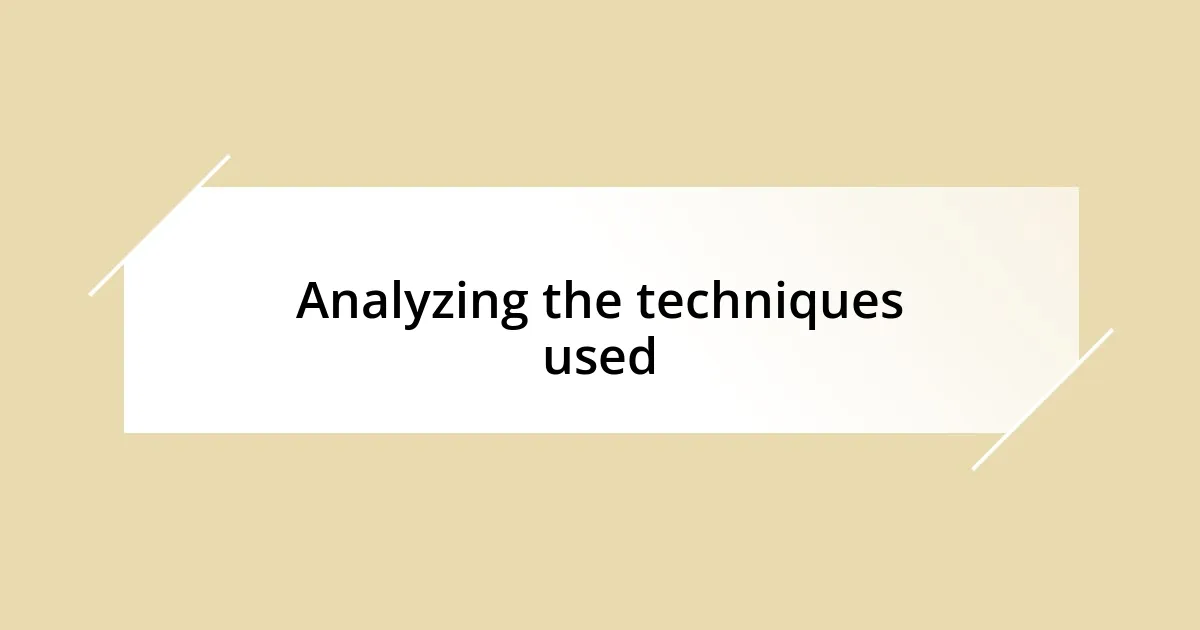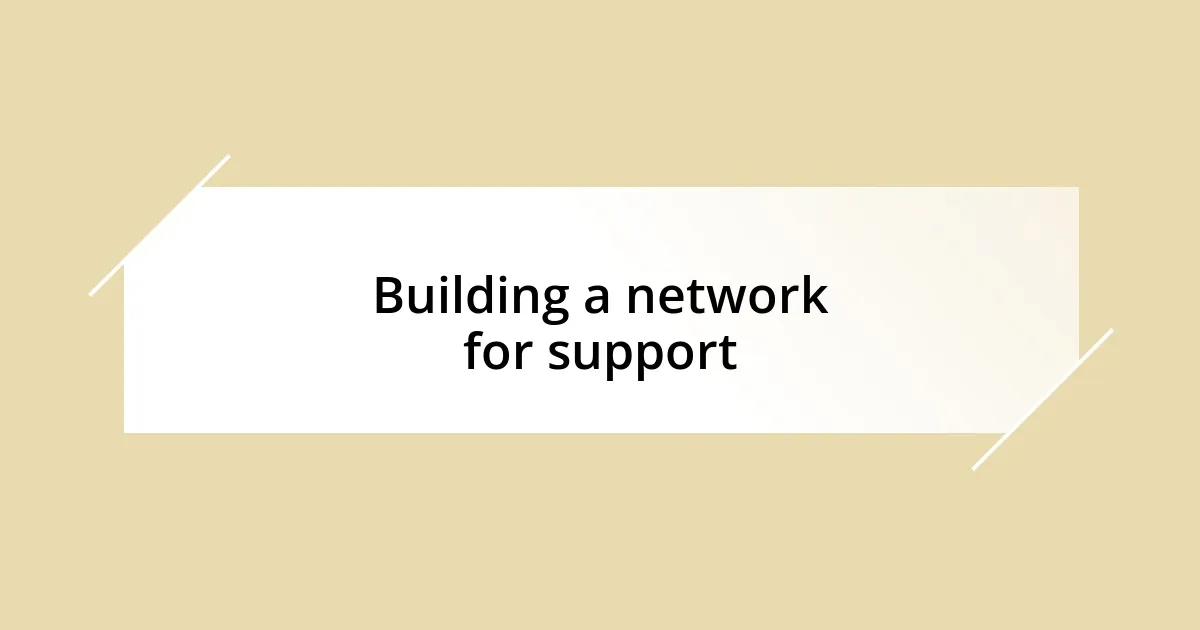Key takeaways:
- Misinformation campaigns manipulate emotions and exploit biases, making critical thinking essential for discerning truth from falsehoods.
- Identifying sources of misinformation involves recognizing red flags, such as emotional language and lack of evidence.
- Engaging with fact-checking resources transforms panic into clarity, equipping individuals to confront false narratives with confidence.
- Building a supportive network fosters collaborative efforts in tackling misinformation, enhancing community resilience against misleading claims.

Understanding misinformation campaigns
Misinformation campaigns thrive on manipulation, often targeting our emotions and exploiting our pre-existing beliefs. I recall a time when a viral social media post rattled my community, causing fear and division. It made me wonder, why do we allow such content to influence us without questioning its validity?
These campaigns can spread like wildfire, fueled by the echo chambers of social media, where confirmation bias flourishes. I remember feeling infuriated and helpless as I watched friends share misleading narratives instead of seeking the truth. It raises an important question: Why is it easier to believe sensational stories than to challenge our understanding of facts?
One of the most disheartening aspects of misinformation is its ability to breed mistrust. I found myself questioning information sources I once relied on, which felt unsettling. How many times do we let doubt cloud our judgment, thinking we’re being cautious, when in reality, we might be falling deeper into a web of misinformation?

Identifying the sources of misinformation
Identifying the sources of misinformation requires a keen eye and a bit of skepticism. I vividly remember the moment I stumbled upon a striking article online that claimed a notorious event had occurred, but something felt off. I decided to dig deeper, cross-referencing with reputable news outlets. That experience taught me that not all sources are created equal, and a critical mindset can uncover the truth hidden within a sea of falsehoods.
One technique I use to identify misinformation is spotting the red flags in how information is presented. For instance, if an article heavily relies on emotional language or makes outrageous claims without supporting evidence, it’s a signal to question its authenticity. I recall coming across a post that used sensational images to back up a misleading story. My instinct pushed me to investigate the claims further, leading me to a fact-checking website that debunked the entire narrative. This experience reinforced my belief in scrutinizing the presentation of information as a vital step in unraveling the truth.
Moreover, understanding the motivations behind certain messages can also reveal their legitimacy. I once encountered a post that pushed a specific political agenda, clearly biased and lacking credible sources. It struck me how easy it was for misinformation to align with our values, making it more palatable. Recognizing this tendency has helped me remain vigilant in my pursuit of reliable information.
| Source Type | Characteristics |
|---|---|
| Mainstream News | Fact-checked, balanced reporting, often with multiple sources |
| Social Media Posts | Can be biased, relies on emotional appeal, often lacks citations |
| Personal Blogs | Varies widely in accuracy, often reflects individual opinions |
| Fact-Checking Websites | Reliable for verification, typically provides sources and context |

Analyzing the techniques used
Analyzing the techniques used in misinformation campaigns reveals a complex web of strategies designed to capture attention and manipulate beliefs. During one incident, I found myself drawn into a deeply shared video that presented distorted facts. It was disconcerting how the creators expertly wove emotionally charged visuals with half-truths, leaving me momentarily mesmerized. It struck me just how powerful emotional resonance is in hijacking rational thought.
Understanding these techniques can help us guard against misinformation. Here are some common methods that often creep into these campaigns:
- Emotional Manipulation: Content creators use emotionally charged language or graphics to provoke strong feelings, overshadowing logical analysis.
- Appeals to Authority: Misinformation often cites dubious experts or authorities, making it seem credible despite lacking real substantiation.
- Selective Storytelling: By cherry-picking facts or anecdotes, these narratives paint a misleading picture, encouraging audiences to draw false conclusions.
- Repetition: The more a claim is repeated, the more believable it becomes. This is especially potent in echo chambers where people seldom encounter differing viewpoints.
- Urgency and Fear-Mongering: Many campaigns create a false sense of urgency, pushing audiences to react emotionally rather than thoughtfully, often leading to rash decisions.
In my own experience, I witnessed a friend share a misleading post that claimed a new law would have devastating effects on our community. The urgency in the message ignited fear, and it took genuine conversations to clarify the exaggerated claims. This taught me the importance of recognizing these manipulation tactics, allowing me to approach information more critically and thoughtfully.

Developing critical thinking skills
Developing critical thinking skills is essential in navigating a landscape filled with misinformation. I remember a discussion I had with a friend who fervently believed in a conspiracy theory. Instead of dismissing his claims outright, I challenged him with questions. “What evidence do you have?” I asked, gently probing his thought process. This not only opened a dialogue but also encouraged him to reconsider the basis of his beliefs. It dawned on me then that asking questions can be a powerful tool in fostering critical thinking.
I also practice the habit of seeking out multiple perspectives on a topic. For instance, when a viral claim about a health treatment caught my attention, I didn’t settle for the first article I read. I explored diverse sources, from peer-reviewed studies to expert opinions, and I found wildly different conclusions. This experience reinforced my view that critical thinking isn’t just about skepticism; it’s about embracing a breadth of viewpoints to form a well-rounded understanding.
How can we train ourselves to be more discerning consumers of information? One method I’ve found effective is reflecting on my biases. I ask myself, “Am I more inclined to believe this because it aligns with my beliefs?” Recognizing my predispositions has been eye-opening. It has nudged me to seek information that challenges my views, ultimately enriching my understanding and sharpening my critical thinking skills. Engaging with content that questions my perspective invites growth and clarity.

Engaging in fact-checking resources
Engaging with fact-checking resources has been a game changer for me when confronting misinformation. There have been times when I’ve stumbled upon outrageous claims on social media—like that one viral post suggesting a celebrity endorsed a dubious product. Instantly, I felt an urge to share it, but thankfully, I took a step back. I turned to established fact-checking sites, like Snopes and FactCheck.org, to verify the information. Not only did this save me from sharing falsehoods, but it also equipped me with evidence to discuss the issue intelligently with friends later on.
One of the insights I’ve had while using these resources is their ability to transform panic into clarity. After reading a sensationalized claim about a crisis, I noticed how easy it was to feel fear and urgency. By cross-referencing with fact-checkers, I found out that many of these claims were exaggerated or misleading. It felt liberating to sift through the noise and arrive at a more accurate understanding. I began to see fact-checking as not just a tool, but as a safety net that allows me to engage with news and opinions without the emotional weight of misinformation dragging me down.
Have you ever wondered how much misinformation could be reduced through a simple click? Each time I check a fact, I’m reminded how vital it is to question what I see. For instance, I remember a heated online debate I had with a group over a proposed policy. A quick fact-check revealed that the majority of the claims were unfounded. Sharing those results transformed the tone of the conversation from hostility to constructive dialogue. Engaging with fact-checking resources not only supports my stance with credible evidence but also fosters a more informed and responsive community.

Communicating effectively against misinformation
When it comes to communicating effectively against misinformation, I’ve found that simplicity and clarity are essential. I once participated in a community discussion where misinformation about local health guidelines was rampant. Instead of diving into complex jargon, I opted for clear, straightforward language to explain the facts. This made it easier for my neighbors to grasp the truth without feeling overwhelmed, creating an atmosphere where dialogue could flourish.
Another critical aspect is empathy. I remember speaking with someone who was deeply entrenched in a false narrative. Instead of dismissing their beliefs, I took a moment to understand their feelings and motivations. I asked, “What led you to feel this way?” Listening attentively opened a pathway to share accurate information without triggering defensiveness. It highlighted for me that successful communication isn’t just about presenting facts; it’s about connecting on a human level.
Have you ever noticed how passionate people can become about their beliefs? By recognizing this, I’ve leaned into strategies that celebrate our shared humanity. When addressing a misleading claim, I often frame it around common values—like safety and community well-being. For example, during a conversation about vaccine misinformation, I emphasized the importance of protecting our loved ones. This tactic not only guided the discussion toward factual information but also created a collaborative spirit where we could explore solutions together.

Building a network for support
Building a network of support is crucial when facing misinformation. I remember the first time I shared concerns with a close friend about a viral conspiracy theory. Instead of skepticism, I was met with a wave of encouragement. Together, we began digging deeper into the claims. We found that having someone by my side not only lightened the burden but also increased our confidence in challenging those narratives. Collaborative conversations like this foster a sense of community, making it easier to tackle misinformation as a united front.
It’s fascinating how a support network can empower you to act. Recently, I joined a local online group focused on media literacy. This community has been instrumental in keeping me informed and motivated. From sharing helpful articles to organizing workshops, I’ve learned so much just by engaging with others who share the same passion. Have you ever participated in a group that broadened your perspectives? I know I have, and I can’t stress enough how enriching it is to exchange ideas and strategies.
When we come together, the fight against misinformation feels less daunting. I recall a virtual meeting where we collectively debunked a trending false narrative within minutes. Everyone contributed their insights, turning a potentially overwhelming topic into an informed discussion. The joy in that moment emphasized for me the importance of building relationships with others who care about the truth. After all, in a world filled with misinformation, collaborating with a network dedicated to finding and sharing facts can be a powerful antidote.














